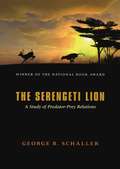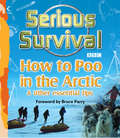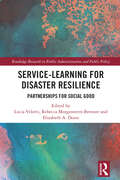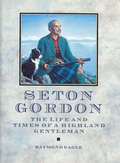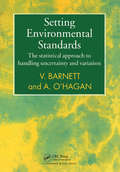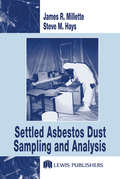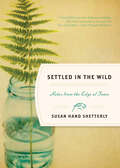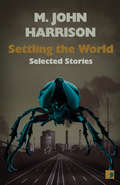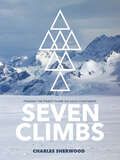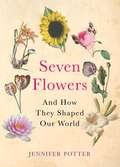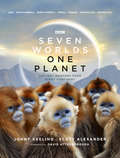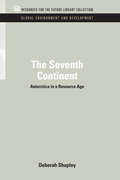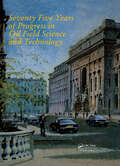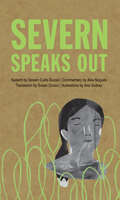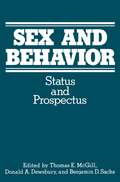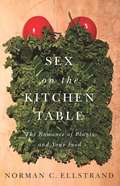- Table View
- List View
The Serengeti Lion: A Study of Predator-Prey Relations (Wildlife Behavior and Ecology series)
by George B. SchallerBased on three years of study in the Serengeti National Park, George B. Schaller’s The Serengeti Lion describes the vast impact of the lion and other predators on the vast herds of wildebeest, zebra, and gazelle for which the area is famous. The most comprehensive book available on the lion, this classic work includes the author’s findings on all aspects of lion behavior, including its social system, population dynamics, hunting behavior, and predation patterns. “If you have only enough time to read one book about field biology, this is the one I recommend.”—Edward O. Wilson, Science “This book conveys not only the fascination of its particular study of lion behavior but the drama and wonder and beauty of the intimate interdependence of all living things.”—Saturday Review “This is an important book, not just for its valuable information on lions, but for its broad, open, and intelligent approach to problems that cut across the fields of behavior, populations, ecology, wildlife management, evolution, anthropology, and comparative biology.”—Richard G. Van Gelder, Bioscience
The Serengeti Lion: A Study of Predator-Prey Relations (Wildlife Behavior and Ecology series)
by George B. SchallerBased on three years of study in the Serengeti National Park, George B. Schaller’s The Serengeti Lion describes the vast impact of the lion and other predators on the vast herds of wildebeest, zebra, and gazelle for which the area is famous. The most comprehensive book available on the lion, this classic work includes the author’s findings on all aspects of lion behavior, including its social system, population dynamics, hunting behavior, and predation patterns. “If you have only enough time to read one book about field biology, this is the one I recommend.”—Edward O. Wilson, Science “This book conveys not only the fascination of its particular study of lion behavior but the drama and wonder and beauty of the intimate interdependence of all living things.”—Saturday Review “This is an important book, not just for its valuable information on lions, but for its broad, open, and intelligent approach to problems that cut across the fields of behavior, populations, ecology, wildlife management, evolution, anthropology, and comparative biology.”—Richard G. Van Gelder, Bioscience
Serious Survival: How To Poo In The Arctic And Other Essential Tips For Explorers
by Marshall CorwinOver a period of five years, the BBC took groups to the world’s most inhospitable places for Serious Jungle, Serious Amazon, Serious Desert, Serious Andes and Serious Arctic. This is what they had to learn to survive…
Service-Learning for Disaster Resilience: Partnerships for Social Good (Routledge Research in Public Administration and Public Policy)
by Lucia Velotti Rebecca Morgenstern Brenner Elizabeth A. DunnThis book is the first to discuss, in practical and theoretical terms, the pedagogical approach of service-learning to establish partnerships for social good that build disaster resilience. Across 12 chapters a collection of academics and practitioners provide insights on the benefits of utilizing service-learning to address existing needs, build community capacity, and strengthen social networks while enhancing student learning.Key features: Discuss how sustainable service-learning partnerships can contribute to building disaster-resilient communities; Provide practical tools to cultivate and manage collaborative partnerships, and engage in reflective practices; Integrate disciplines to create innovative approaches to complex problems; Share best practices, lessons learned, and case examples that identify strategies for integrating service-learning and research into course design; Offer considerations for ethical decision-making and for the development of equitable solutions when engaging with stakeholders; Identify strategies to bridge the gap between academia and practice while highlighting resources that institutions of higher education can contribute toward disaster preparedness, response, recovery, and mitigation. Service-Learning for Disaster Resilience will serve as a user-friendly guide for universities, local government agencies, emergency management professionals, community leaders, and grassroots initiatives in affected communities.
Service-Learning for Disaster Resilience: Partnerships for Social Good (Routledge Research in Public Administration and Public Policy)
by Lucia Velotti Rebecca Morgenstern Brenner Elizabeth A. DunnThis book is the first to discuss, in practical and theoretical terms, the pedagogical approach of service-learning to establish partnerships for social good that build disaster resilience. Across 12 chapters a collection of academics and practitioners provide insights on the benefits of utilizing service-learning to address existing needs, build community capacity, and strengthen social networks while enhancing student learning.Key features: Discuss how sustainable service-learning partnerships can contribute to building disaster-resilient communities; Provide practical tools to cultivate and manage collaborative partnerships, and engage in reflective practices; Integrate disciplines to create innovative approaches to complex problems; Share best practices, lessons learned, and case examples that identify strategies for integrating service-learning and research into course design; Offer considerations for ethical decision-making and for the development of equitable solutions when engaging with stakeholders; Identify strategies to bridge the gap between academia and practice while highlighting resources that institutions of higher education can contribute toward disaster preparedness, response, recovery, and mitigation. Service-Learning for Disaster Resilience will serve as a user-friendly guide for universities, local government agencies, emergency management professionals, community leaders, and grassroots initiatives in affected communities.
Seton Gordon: The Life and Times of a Highland Gentleman
by Raymond EagleSeton Gordon was born in 1886 into an Aberdeenshire family and was to live to the age of 91. In that time his life spanned some of the most momentous changes in civilisation and yet his travels rarely took him away from Scotland for long. He dedicated his life to natural history and in his awareness of the environment he was ahead of his time.He wore the kilt as everyday dress and entered college in 1908 to take a degree in natural sciences at Exeter College, Oxford. Whilst there he befriended the Prince of Wales, who was to correspond with him after he left university. In later life he also corresponded with Ramsay MacDonald.He spent hours roaming the hills of Deeside and the Cairgorm plateau while observing nature and would sustain incredible hardships in pursuit of his favourite bird, the golden eagle. He became engaged to Audrey Pease in 1915 and after marriage, they moved to the Isle of Skye where they settled in Trotternish and where he began to write on all aspects of Highland and Hebridean life. Over the years he produced prose which managed to place man in his proper context in the environment, and these books inspired countless numbers to look to the hills and corries in search of Scotland's wilderness areas.His ethereal descriptions of the Western Isles, whether in sun or in rain, a but the real contribution of are perhaps his most finely observed pieces but the real contribution of his 28 books and numerous articles and papers was to the sum of knowledge on the natural history of the Highlands and Islands. He will be remembered by all who knew him, read him and heard him speak as one of the last great Highland gentlemen.Raymond Eagle first met Seton Gordon in Skye in 1949 and was to correspond with him for a number of years. After Eagle moved to Vancouver in 1967, a chance encounter led him to meet Seton's son, Alasdair who had lived in the city for several years. With Alasdair's help, Eagle set out to write this biography which was published in print format in 1990. This is a complete revised Ebook edition with numerous colour and black and white illustrations.
Setting Environmental Standards: The Statistical Approach to Handling Uncertainty and Variation
by Vic Barnett A. O'HaganIntroducing a novel approach to setting environmental pollution standards that allow for proper treatment of uncertainty and variation, this book surveys the forms of standards and proposes a new kind of "statistically verifiable ideal standard."Setting Environmental Standards includes:a current analysis regarding the treatment of uncertainty and variation in environmental standard settinga review of basic principles in standard setting, including costs, actions and effects, and benefitsexamples where uncertainty and variation have been well-treated in current practice as well as examples where clear deficiencies are apparentspecific proposals for the future approach to setting environmental pollution standards - encompassing the anticipated elements of uncertainty and variabilityThe issues discussed serve statisticians as well as those persons involved with environmental standards. Scientists in agencies responsible for setting standards, in organizations advising such agencies or working in industries subject to these standards, will find Setting Environmental Standards an invaluable reference.
Setting Environmental Standards: The Statistical Approach to Handling Uncertainty and Variation
by Vic Barnett A. O'HaganIntroducing a novel approach to setting environmental pollution standards that allow for proper treatment of uncertainty and variation, this book surveys the forms of standards and proposes a new kind of "statistically verifiable ideal standard."Setting Environmental Standards includes:a current analysis regarding the treatment of uncertainty and variation in environmental standard settinga review of basic principles in standard setting, including costs, actions and effects, and benefitsexamples where uncertainty and variation have been well-treated in current practice as well as examples where clear deficiencies are apparentspecific proposals for the future approach to setting environmental pollution standards - encompassing the anticipated elements of uncertainty and variabilityThe issues discussed serve statisticians as well as those persons involved with environmental standards. Scientists in agencies responsible for setting standards, in organizations advising such agencies or working in industries subject to these standards, will find Setting Environmental Standards an invaluable reference.
Settled Asbestos Dust Sampling and Analysis
by Steve M. Hays James R. MilletteSettled Asbestos Dust Sampling and Analysis compiles the most significant data on asbestos in settled dust. This ready reference presents an analysis of settled dusts and surface particles of all sizes for asbestosthat is useful for qualitative and quantitative assessment and helps to determine the source of fibers. The main scope of this reference includes sample collection, sample analyses, and interpretation of settled dust data, as well as the use of such data for purposes including asbestos abatement projects and in-place management programs. Sections on lead and other particulates are also included.
Settled Asbestos Dust Sampling and Analysis
by Steve M. Hays James R. MilletteSettled Asbestos Dust Sampling and Analysis compiles the most significant data on asbestos in settled dust. This ready reference presents an analysis of settled dusts and surface particles of all sizes for asbestosthat is useful for qualitative and quantitative assessment and helps to determine the source of fibers. The main scope of this reference includes sample collection, sample analyses, and interpretation of settled dust data, as well as the use of such data for purposes including asbestos abatement projects and in-place management programs. Sections on lead and other particulates are also included.
Settled in the Wild: Notes from the Edge of Town
by Susan Hand ShetterlyWhether we live in cities, suburbs, or villages, we are encroaching on nature, and it in one way or another perseveres. Naturalist Susan Shetterly looks at how animals, humans, and plants share the land—observing her own neighborhood in rural Maine. She tells tales of the locals (humans, yes, but also snowshoe hares, raccoons, bobcats, turtles, salmon, ravens, hummingbirds, cormorants, sandpipers, and spring peepers). She expertly shows us how they all make their way in an ever-changing habitat. In writing about a displaced garter snake, witnessing the paving of a beloved dirt road, trapping a cricket with her young son, rescuing a fledgling raven, or the town's joy at the return of the alewife migration, Shetterly issues warnings even as she pays tribute to the resilience that abounds. Like the works of Annie Dillard and Aldo Leopold, Settled in the Wild takes a magnifying glass to the wildness that surrounds us. With keen perception and wit, Shetterly offers us an education in nature, one that should inspire us to preserve it.
Settling the World: Selected Stories
by M. John HarrisonThroughout his career, M. John Harrison’s writing has defied categorisation, building worlds both unreal and all-too real, overlapping and interlocking with each other. His stories are replete with fissures and portals into parallel dimensions, unidentified countries and lost lands. But more important than the places they point to are the obsessions that drive the people who so believe in them, characters who spend their lives hunting for, and haunted by, clues and maps that speak to the possibility of somewhere else. This selection of stories, drawn from over 50 years of writing, bears witness to that desire for difference: whether following backstreet occultists, amateur philosophers, down-and-outs or refugees, we see our relationship with ‘the other’ in microscopic detail, and share in Harrison’s rejection of the idea that the world, or our understanding of it, could ever be settled.
Seven Climbs: Finding the finest climb on each continent
by Charles Sherwood'Even the most casual reader among you will by now have worked out that the whole thing is little more than a delightful ruse for having a very good time.'Experienced climber Charles Sherwood is on a quest to find the best climb on each continent. He eschews the traditional Seven Summits, where height alone is the determining factor, and instead considers mountaineering challenge, natural beauty and historical context, aiming to capture the diverse character of each continent and the sheer variety of climbing in all its forms.The author's ambitious odyssey takes him to the Alps, the Himalaya, Yosemite, the Andes, Kenya, New Zealand and South Georgia. His goal is neither to seek glory nor to complete a box-ticking exercise, but simply to enjoy himself in the company of his fellow climbers, including Mark Seaton, Andy Kirkpatrick and Stephen Venables, and to appreciate the splendour of his surroundings. On classic routes like the North Face of the Eiger and the Nose on El Capitan, it is hard not to be swept away by Sherwood's unfaltering enthusiasm.Also featuring fascinating historical detail about each route, Seven Climbs is a compelling account of Sherwood's efforts to answer a much-debated question: which are the world’s greatest climbs?
Seven Flowers: SHORTLISTED FOR THE GARDEN MEDIA AWARDS
by Jennifer Potter**SHORTLISTED FOR THE GARDEN MEDIA AWARDS, INSPIRATIONAL BOOK OF THE YEAR**The lotus, lily, sunflower, opium poppy, rose, tulip and orchid. Seven flowers: seven stories full of surprise and secrets. Where and when did these flowers originate? What is the nature of their power and how was it acquired? What use has been made of them in gardens, literature and art? These are both histories and detective stories, full of incident, unexpected revelations, and irony. The opium poppy, for example, returned to haunt its progenitors in the West; and while Confucius saw virtue and modesty in his native orchids, the ancient Greeks saw only sex.These are flowers of life and death; of purity and passion; of greed, envy and virtue; of hope and consolation; of the beauty that drives men wild. All seven demonstrate the enduring ability of flowers to speak metaphorically - if we could only decode what they have to say.
Seven Worlds One Planet: One Planet
by Jonny Keeling Scott AlexanderWelcome home. A place 200 million years in the making.Long ago, our planet had only one gigantic land mass. Then something monumental happened. That supercontinent ruptured and seven different worlds were born. Each of those worlds - or continents - evolved, and continues to evolve, its own way of life. From the jungle of the Congo or the majestic Himalayas to the densely populated wilds of Europe or the comparatively isolated Australasia, Seven Worlds, One Planet explores the natural wonders that give each of our continents its distinct character. Following the animals that have made these iconic environments their home, it discovers spectacular wildlife stories that reveal what makes each of these seven worlds unique. With a foreword by Sir David Attenborough and over 250 breathtaking images, including stills from the BBC Natural History Unit’s spectacular footage, Seven Worlds, One Planet is a stunning exploration of the planet, and the worlds within it, that we call home.
The Seventh Continent: Antarctica in a Resource Age (RFF Global Environment and Development Set)
by Deborah ShapleyFirst Published in 2011. Routledge is an imprint of Taylor & Francis, an informa company.
The Seventh Continent: Antarctica in a Resource Age (RFF Global Environment and Development Set)
by Deborah ShapleyFirst Published in 2011. Routledge is an imprint of Taylor & Francis, an informa company.
Seventy Five Years of Progress in Oil Field Science and Technology: Proceedings of the 75th anniversary symposium, London, 12 July 1988
by M. AlaThis volume contains the proceedings of the 75th anniversary of Progress in Oil Field Science and Technology as gathered at the symposium in London on 12th July 1988.
Seventy Five Years of Progress in Oil Field Science and Technology: Proceedings of the 75th anniversary symposium, London, 12 July 1988
by M.ALA; H.HATAMIAN; G.D.HOBSON; M.S.KING; I.WILLIAMSONThis volume contains the proceedings of the 75th anniversary of Progress in Oil Field Science and Technology as gathered at the symposium in London on 12th July 1988.
Severn Speaks Out (Speak Out #1)
by Severn Cullis-SuzukiBefore Greta Thunberg there was Severn Cullis-Suzuki, whose 1992 Earth Summit speech made her known as “the girl who silenced the world for five minutes.” Severn Cullis-Suzuki was only twelve years old when she addressed the whole world and asked: What are you doing to the Earth, our home? How far can human greed go? Young Severn looked at the world leaders in attendance and said, “I’m only a child, and I don’t have all the solutions, but I want you to realize, neither do you!” She entreated those world leaders to make their actions reflect their words and to protect the Earth for generations to come. Severn’s speech is even more urgent today than it was thirty years ago. Beautiful illustrations accompany her words in this first book in the Speak Out series, followed by an analysis written by Alex Nogués that gives readers more detail about Severn’s life and the context of her speech, while highlighting the most powerful and persuasive points of her address. The Speak Out series publishes the most inspiring speeches of our times, then deconstructs them to give young readers a deeper understanding of global issues and the power of language to influence them. Key Text Features biographical information definitions explanation facts headings historical context illustrations informational note Correlates to the Common Core State Standards in English Language Arts: CCSS.ELA-LITERACY.RI.5.8 Explain how an author uses reasons and evidence to support particular points in a text, identifying which reasons and evidence support which point(s). CCSS.ELA-LITERACY.RI.6.3 Analyze in detail how a key individual, event, or idea is introduced, illustrated, and elaborated in a text (e.g., through examples or anecdotes). CCSS.ELA-LITERACY.RI.6.5 Analyze how a particular sentence, paragraph, chapter, or section fits into the overall structure of a text and contributes to the development of the ideas. CCSS.ELA-LITERACY.RI.6.6 Determine an author's point of view or purpose in a text and explain how it is conveyed in the text.
Sew & Stow: 31 Fun Sewing Projects to Carry, Hold, and Organize Your Stuff, Your Home, and Yourself!
by Betty OppenheimerIndulge your passion for sewing as you clear your life of clutter. Whatever your experience and wherever the mess, you can sew up a cloth sack or organizer to fit your needs. Gardening tools, groceries, shoes, toys, jewelry, and more will find new homes in these colorful and reusable handmade alternatives to mass-produced products. With Betty Oppenheimer&’s easy-to-follow instructions for 31 fun and functional projects, you&’ll be inspired to break out your needles and create a more organized, bright, and eco-friendly home.
Sew What! Bags: 18 Pattern-Free Projects You Can Customize to Fit Your Needs
by Lexie BarnesFrom daypacks for hiking to everyday grocery totes, bags are an essential accessory for life on the go. In this inspiring guide, Lexie Barnes shows you how to create handmade bags that provide customized functionality while showcasing your own personal style. With step-by-step instructions for 18 pattern-free projects that include drawstring sacks, handbags, and messenger bags, Barnes encourages you to experiment with bold fabrics, hand-picked materials, and purpose-tailored dimensions to create fashionably unique bags that are suitable for your individual needs.
Sex and Behavior: Status and Prospectus
by McgillDiscussion of the precise nature and position of boundaries between dis ciplines is nearly always counterproductive; the need is usually to cross them not to emphasize them. And any such discussion of the distinction between ethology and comparative psychology would today seem patently absurd. While there may be differences in outlook, no boundaries exist. But when Frank Beach started in research, that was not the case. Comparative psychology flourished in the United States whereas ethology was unknown. Beach started as a comparative psychologist and has always called himself either that or a behavioral endocrinologist. Yet, among the com parative psychologists of his generation, he has had closer links with the initially European ethologists than almost any other. He was indeed one of the editors of the first volume of Behaviour. That this should have been so is not surprising once one knows that his Ph. D. thesis concerned "The Neural Basis for Innate Behavior," that he used to sleep in the laboratory so that he could watch mother rats giving birth, and that in 1935 he was using model young to analyze maternal behavior. Furthermore, for nine years he worked in the American Museum of Natural History-in a department first named Experimental Biology and later, when Beach had saved it from extinction and become its chairman, the Department of Animal Behavior. It was in 1938, during Frank's time at the American Museum, that he was first introduced to Niko Tinbergen by Ernst Mayr.
Sex on the Kitchen Table: The Romance of Plants and Your Food
by Norman C. EllstrandAt the tips of our forks and on our dinner plates, a buffet of botanical dalliance awaits us. Sex and food are intimately intertwined, and this relationship is nowhere more evident than among the plants that sustain us. From lascivious legumes to horny hot peppers, most of humanity’s calories and other nutrition come from seeds and fruits—the products of sex—or from flowers, the organs that make plant sex possible. Sex has also played an arm’s-length role in delivering plant food to our stomachs, as human handmade evolution (plant breeding, or artificial selection) has turned wild species into domesticated staples. In Sex on the Kitchen Table, Norman C. Ellstrand takes us on a vegetable-laced tour of this entire sexual adventure. Starting with the love apple (otherwise known as the tomato) as a platform for understanding the kaleidoscopic ways that plants can engage in sex, successive chapters explore the sex lives of a range of food crops, including bananas, avocados, and beets, finally ending with genetically engineered squash—a controversial, virus-resistant vegetable created by a process that involves the most ancient form of sex. Peppered throughout are original illustrations and delicious recipes, from sweet and savory tomato pudding to banana puffed pancakes, avocado toast (of course), and both transgenic and non-GMO tacos. An eye-opening medley of serious science, culinary delights, and humor, Sex on the Kitchen Table offers new insight into fornicating flowers, salacious squash, and what we owe to them. So as we sit down to dine and ready for that first bite, let us say a special grace for our vegetal vittles: let’s thank sex for getting them to our kitchen table.
Sex on the Kitchen Table: The Romance of Plants and Your Food
by Norman C. EllstrandAt the tips of our forks and on our dinner plates, a buffet of botanical dalliance awaits us. Sex and food are intimately intertwined, and this relationship is nowhere more evident than among the plants that sustain us. From lascivious legumes to horny hot peppers, most of humanity’s calories and other nutrition come from seeds and fruits—the products of sex—or from flowers, the organs that make plant sex possible. Sex has also played an arm’s-length role in delivering plant food to our stomachs, as human handmade evolution (plant breeding, or artificial selection) has turned wild species into domesticated staples. In Sex on the Kitchen Table, Norman C. Ellstrand takes us on a vegetable-laced tour of this entire sexual adventure. Starting with the love apple (otherwise known as the tomato) as a platform for understanding the kaleidoscopic ways that plants can engage in sex, successive chapters explore the sex lives of a range of food crops, including bananas, avocados, and beets, finally ending with genetically engineered squash—a controversial, virus-resistant vegetable created by a process that involves the most ancient form of sex. Peppered throughout are original illustrations and delicious recipes, from sweet and savory tomato pudding to banana puffed pancakes, avocado toast (of course), and both transgenic and non-GMO tacos. An eye-opening medley of serious science, culinary delights, and humor, Sex on the Kitchen Table offers new insight into fornicating flowers, salacious squash, and what we owe to them. So as we sit down to dine and ready for that first bite, let us say a special grace for our vegetal vittles: let’s thank sex for getting them to our kitchen table.
